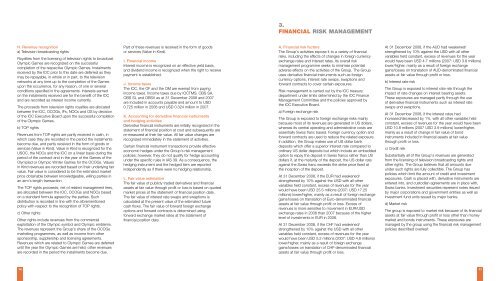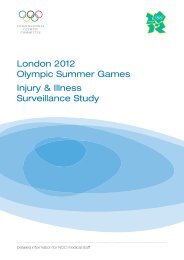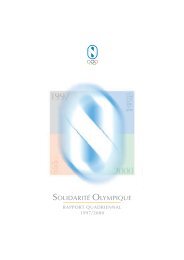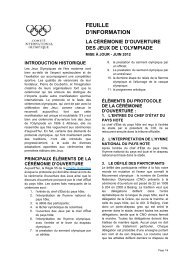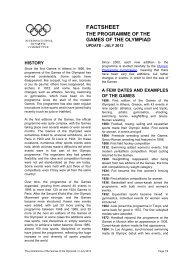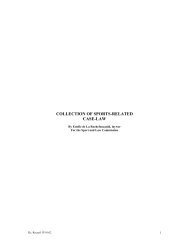3912 reportcomplete final web:layout 1
3912 reportcomplete final web:layout 1
3912 reportcomplete final web:layout 1
Create successful ePaper yourself
Turn your PDF publications into a flip-book with our unique Google optimized e-Paper software.
H. Revenue recognition<br />
a) Television broadcasting rights<br />
Royalties from the licensing of television rights to broadcast<br />
Olympic Games are recognized on the successful<br />
completion of the respective Olympic Games. Instalments<br />
received by the IOC prior to this date are deferred as they<br />
may be repayable, in whole or in part, to the television<br />
networks at any time up to the completion of the Games<br />
upon the occurrence, for any reason, of one or several<br />
conditions specified in the agreements. Interests earned<br />
on the instalments received are for the benefit of the IOC<br />
and are recorded as interest income currently.<br />
The proceeds from television rights royalties are allocated<br />
between the IOC, OCOGs, IFs, NOCs and OS by decision<br />
of the IOC Executive Board upon the successful completion<br />
of the Olympic Games.<br />
b) TOP rights<br />
Revenues from TOP rights are partly received in cash, in<br />
which case they are recorded in the period the instalments<br />
become due, and partly received in the form of goods or<br />
services (Value in Kind). Value in Kind is recognized for the<br />
USOC, the NOCs and the IOC on a linear basis during the<br />
period of the contract and in the year of the Games of the<br />
Olympiad or Olympic Winter Games for the OCOGs. Values<br />
in Kind revenues are recorded based on their underlying fair<br />
value. Fair value is considered to be the estimated market<br />
price obtainable between knowledgeable, willing parties in<br />
an arm’s length transaction.<br />
The TOP rights proceeds, net of related management fees,<br />
are allocated between the IOC, OCOGs and NOCs based<br />
on a standard formula agreed by the parties. Such<br />
distribution is recorded in line with the aforementioned<br />
policy with respect to the recognition of TOP rights.<br />
c) Other rights<br />
Other rights include revenues from the commercial<br />
exploitation of the Olympic symbol and Olympic emblems.<br />
The revenues represent the Group’s share of the OCOGs<br />
marketing programmes, as well as income from other<br />
sponsorship, suppliership and licensing agreements.<br />
Revenues which are related to Olympic Games are deferred<br />
until the year the Olympic Games are held; other revenues<br />
are recorded in the period the instalments become due.<br />
Part of these revenues is received in the form of goods<br />
or services (Value in Kind).<br />
I. Financial income<br />
Interest income is recognized on an effective yield basis,<br />
and dividend income is recognized when the right to receive<br />
payment is established.<br />
J. Income taxes<br />
The IOC, the OF and the OM are exempt from paying<br />
income taxes. Income taxes due by IOCTMS, OBS SA,<br />
OBS SL and OBSV as at 31 December 2008 and 2007<br />
are included in accounts payable and amount to USD<br />
0.725 million in 2008 and USD 0.324 million in 2007.<br />
K. Accounting for derivative financial instruments<br />
and hedging activities<br />
Derivative financial instruments are initially recognized in the<br />
statement of financial position at cost and subsequently are<br />
re-measured at their fair value. All fair value changes are<br />
recognized immediately in the statement of activities.<br />
Certain financial instrument transactions provide effective<br />
economic hedges under the Group’s risk management<br />
policies; however, they do not qualify for hedge accounting<br />
under the specific rules in IAS 39. As a consequence, the<br />
hedging instrument and the hedged item are reported<br />
independently as if there were no hedging relationship.<br />
L. Fair value estimation<br />
The fair value of publicly traded derivatives and financial<br />
assets at fair value through profit or loss is based on quoted<br />
market prices at the statement of financial position date.<br />
The fair value of interest rate swaps and swaptions is<br />
calculated at the present value of the estimated future<br />
cash flows. The fair value of forward foreign exchange<br />
options and forward contracts is determined using<br />
forward exchange market rates at the statement of<br />
financial position date.<br />
3.<br />
FINANCIAL RISK MANAGEMENT<br />
A. Financial risk factors<br />
The Group’s activities expose it to a variety of financial<br />
risks, including the effects of changes in foreign currency<br />
exchange rates and interest rates. Its overall risk<br />
management programme seeks to minimise potential<br />
adverse effects on the activities of the Group. The Group<br />
uses derivative financial instruments such as foreign<br />
currency options, interest rate swaps, swaptions and<br />
forward contracts to cover certain exposures.<br />
Risk management is carried out by the IOC treasury<br />
department under limits determined by the IOC Finance<br />
Management Committee and the policies approved by<br />
the IOC Executive Board.<br />
a) Foreign exchange risk<br />
The Group is exposed to foreign exchange risks mainly<br />
because most of its revenues are generated in US dollars,<br />
whereas its central operating and administrative costs are<br />
essentially Swiss franc based. Foreign currency option and<br />
forward contracts are used to reduce the related exposure.<br />
In addition, the Group makes use of US dollar bank<br />
deposits which offer a superior interest rate compared to<br />
ordinary US dollar deposits but which include an embedded<br />
option to repay the deposit in Swiss francs rather than US<br />
dollars if, at the maturity of the deposit, the US dollar rate<br />
against the Swiss franc exceeds the strike price fixed at<br />
the inception of the deposit.<br />
At 31 December 2008, if the EUR had weakened/<br />
strengthened by 10% against the USD with all other<br />
variables held constant, excess of revenues for the year<br />
would have been USD 25.5 millions (2007: USD 17.25<br />
millions) lower/higher, mainly as a result of foreign exchange<br />
gains/losses on translation of Euro-denominated financial<br />
assets at fair value through profit or loss. Excess of<br />
revenues is more sensitive to movement in EUR/USD<br />
exchange rates in 2008 than 2007 because of the higher<br />
level of investments in EUR in 2008.<br />
At 31 December 2008, if the CHF had weakened/<br />
strengthened by 10% against the USD with all other<br />
variables held constant, excess of revenues for the year<br />
would have been USD 5.2 millions (2007: USD 4.8 millions)<br />
lower/higher, mainly as a result of foreign exchange<br />
gains/losses on translation of CHF-denominated financial<br />
assets at fair value through profit or loss.<br />
At 31 December 2008, if the AUD had weakened/<br />
strengthened by 10% against the USD with all other<br />
variables held constant, excess of revenues for the year<br />
would have been USD 4.7 millions (2007: USD 3.8 millions)<br />
lower/higher, mainly as a result of foreign exchange<br />
gains/losses on translation of AUD-denominated financial<br />
assets at fair value through profit or loss.<br />
b) Interest rate risk<br />
The Group is exposed to interest rate risk through the<br />
impact of rate changes on interest bearing assets.<br />
These exposures are managed partly through the use<br />
of derivative financial instruments such as interest rate<br />
swaps and swaptions.<br />
At 31 December 2008, if the interest rates had<br />
increased/decreased by 1%, with all other variables held<br />
constant, excess of revenues for the year would have been<br />
USD 10.8 millions (2007 USD 3.9 millions) lower/higher,<br />
mainly as a result of change in fair value of bond<br />
instruments included in financial assets at fair value<br />
through profit or loss.<br />
c) Credit risk<br />
Substantially all of the Group’s revenues are generated<br />
from the licensing of television broadcasting rights and<br />
other rights. The Group believes that all amounts due<br />
under such rights are fully collectible. The Group has<br />
policies which limit the amount of credit and investment<br />
exposures. Cash is placed with, derivative instruments are<br />
entered into, and custodian agreements are in place with,<br />
Swiss banks. Investment securities represent notes issued<br />
by major corporations and government entities as well as<br />
investment fund units issued by major banks.<br />
d) Market risk<br />
The group is exposed to market risk because of its financial<br />
assets at fair value through profit or loss other than money<br />
market and bonds instruments. These exposures are<br />
managed by the group using the financial risk management<br />
policies described overleaf:<br />
76<br />
77


